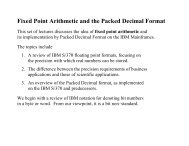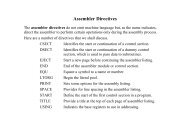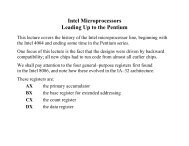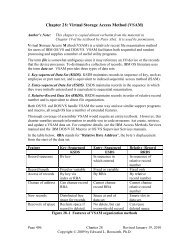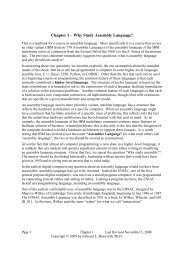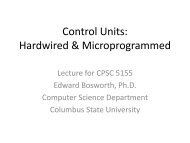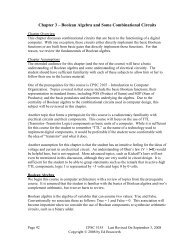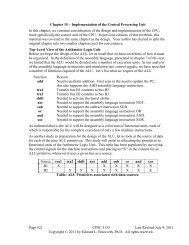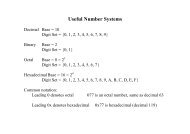Microprogramming: History and Evolution - Edwardbosworth.com
Microprogramming: History and Evolution - Edwardbosworth.com
Microprogramming: History and Evolution - Edwardbosworth.com
You also want an ePaper? Increase the reach of your titles
YUMPU automatically turns print PDFs into web optimized ePapers that Google loves.
Here I just quote our textbook.<br />
The 1960’s <strong>and</strong> 1970’s<br />
―In the 1960s <strong>and</strong> 1970s, microprogramming was one of the most important<br />
techniques used in implementing machines. Through most of that period,<br />
machines were implemented with discrete <strong>com</strong>ponents or MSI (mediumscale<br />
integration—fewer than 1000 gates per chip), ….[Designers could<br />
choose between a hardwired control unit based on a finite–state–machine<br />
model or a microprogrammed control unit].<br />
The reliance on st<strong>and</strong>ard parts of low- to medium-level integration made these<br />
two design styles radically different. Microprogrammed approaches were<br />
attractive because implementing the control with a large collection of lowdensity<br />
gates was extremely costly. Furthermore, the popularity of relatively<br />
<strong>com</strong>plex instruction sets dem<strong>and</strong>ed a large control unit, making a ROM-based<br />
implementation much more efficient. The hardwired implementations were<br />
faster, but too costly for most machines. Furthermore, it was very difficult to<br />
get the control correct, <strong>and</strong> changing ROMs was easier than replacing a<br />
r<strong>and</strong>om logic control unit. Eventually, microprogrammed control was<br />
implemented in RAM, to allow changes late in the design cycle, <strong>and</strong> even in<br />
the field after a machine shipped.‖



